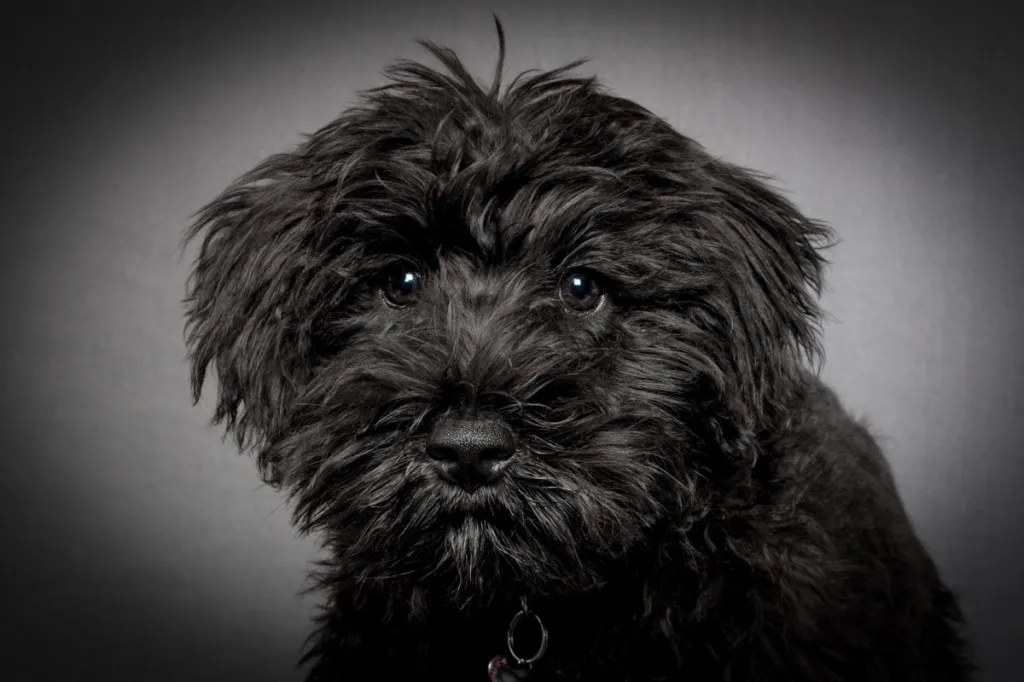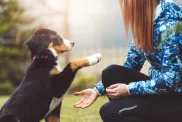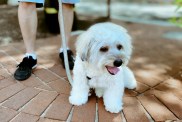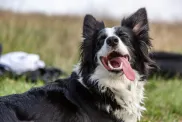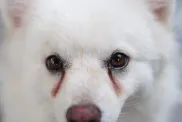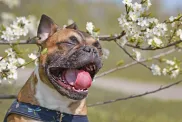What a pistol! Smart, active, and adorable, the Schnoodle has become a popular hybrid dog breed. As a cross between the Poodle and the Schnauzer, their coats can showcase an array of colors, ranging from black, to gray, to white, to sable, to even apricot.
While most Schnoodles are small, their size varies due to the three distinct size variations of both Schnauzers and Poodles. Larger Schnoodles remain relatively uncommon. Currently, there’s no established breed standard for Schnoodles. Given that, their different sizes are simply and loosely categorized as Toy, Miniature, Standard, and Giant. The most common cross involves a Miniature Schnauzer with either a Toy or Miniature Poodle.
With a weight range spanning six to 76 pounds, the Schnoodle has a place as a lap dog, family companion, therapy aid, or even a performance dog. Their role extends to guarding loved ones, showcasing their prowess as diligent protectors. The Schnoodle’s charm lies in the fusion of their parent breeds’ best traits. To clarify, this hybrid‘s appeal stems from often having the Poodle’s willingness to please mixed with the sturdiness and activity of the Schnauzer. Plus, they are whip smart and easy to train. To this end, their sharp intellect and liveliness necessitates a daily need for physical and mental engagement in order to stave off boredom. Otherwise, be prepared to address this pup’s potentially destructive behavior.
Inherent in Schnauzers is a tendency to favor one person over others, a trait often passed down to Schnoodles. While they maintain affection for the entire family, occasional preferences arise. If their favored person remains absent for too long, these dogs may grapple with separation anxiety. Nonetheless, this pup’s playful and affectionate nature thrives on enjoyment, consistently commanding attention and infusing delight into every moment with their loved ones.
Quick Facts
- Origin: Schnoodles were first bred in the United States in the 1980s by crossing Poodles and Schnauzers.
- Size: Schnoodles come in four sizes: Toy, Miniature, Standard, and Giant. A Toy Schnoodle weighs 5-15 pounds, a Miniature Schnoodle weighs 15-30 pounds, a Standard Schnoodle weighs 30-50 pounds, and a Giant Schnoodle weighs around 50-70 pounds.
- Lifespan: Schnoodles typically live 12-15 years.
- Coat: Schnoodles have curly coats that are low-shedding. The most common coat color is black. Be that as it may, their coats can be a variety of colors, including grey, brown, white, apricot, and parti (a combination of two or more colors).
- Temperament: Schnoodles are friendly, intelligent, playful, and loyal dogs. They are good with children and other pets. They can be barkers, so it is important to train them early to stop excessive barking.
- Exercise needs: Schnoodles have moderate exercise needs, requiring at least 30 minutes of exercise per day. They enjoy playing fetch, going for walks, and running around in the yard.
- Training: Schnoodles are easy to train with positive reinforcement. They are intelligent dogs who love to learn new tricks.
- Grooming: Schnoodles need to be brushed weekly to prevent mats and tangles. They also need to be groomed professionally every few months.
- Health: Schnoodles are prone to some health conditions, such as allergies, pancreatitis, and luxating patella.
- Nicknames: Schnoodles are often called “teddy bear dogs” for their soft, curly coats.
- Movie roles: In the 1989 classic animated movie “All Dogs Go To Heaven,” the misnamed character of “Killer” is a tan, glasses-wearing Schnoodle voiced by the late Charles Nelson Reilly.
- TV mentions: In Season 5, Episode 7 of “Rizzoli & Isles,” Chief Medical Examiner Dr. Maura Isles returns to the dating scene. Detective Jane Rizzoli encourages Maura to avoid discussing the intricacies of medical cases, instead suggesting she opt for small talk about puppies. As to be expected, Dr. Isles goes down a rabbit hole after researching hypoallergenic dog breed crosses. In regards to Doodles, Maura proclaims, “And my favorite: The Schnoodle. It’s a Schnauzer/ Poodle.”
Schnoodle Pictures
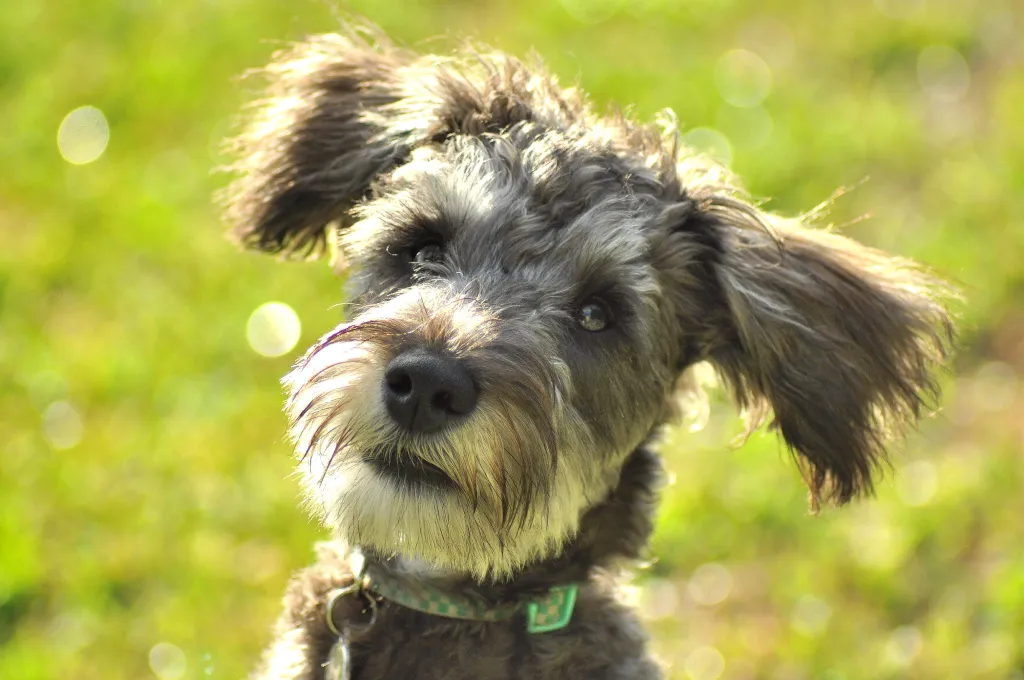
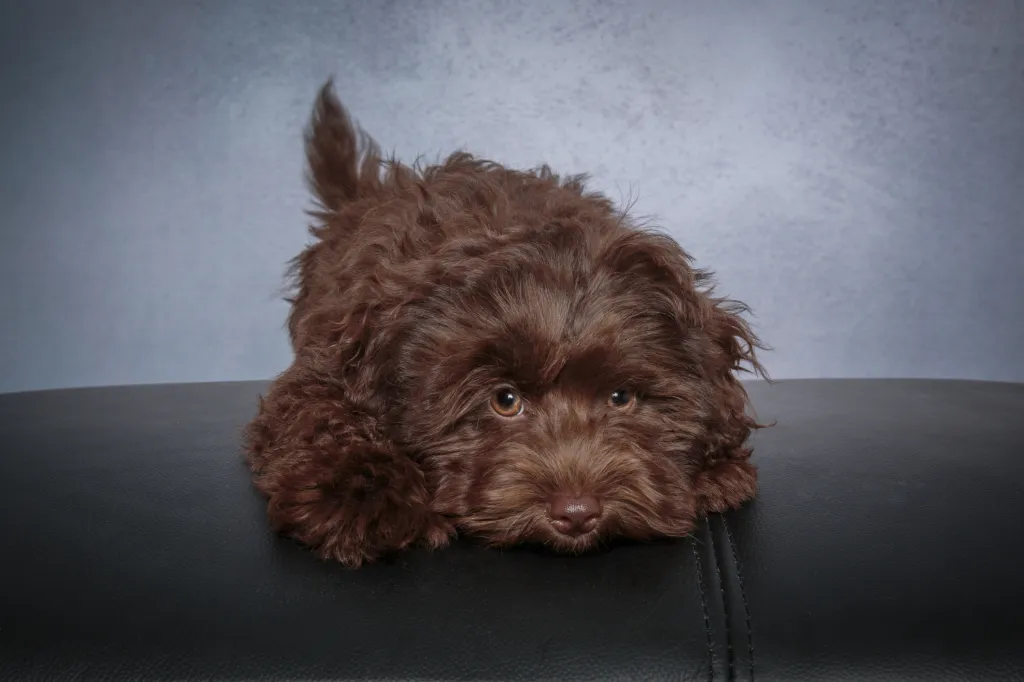
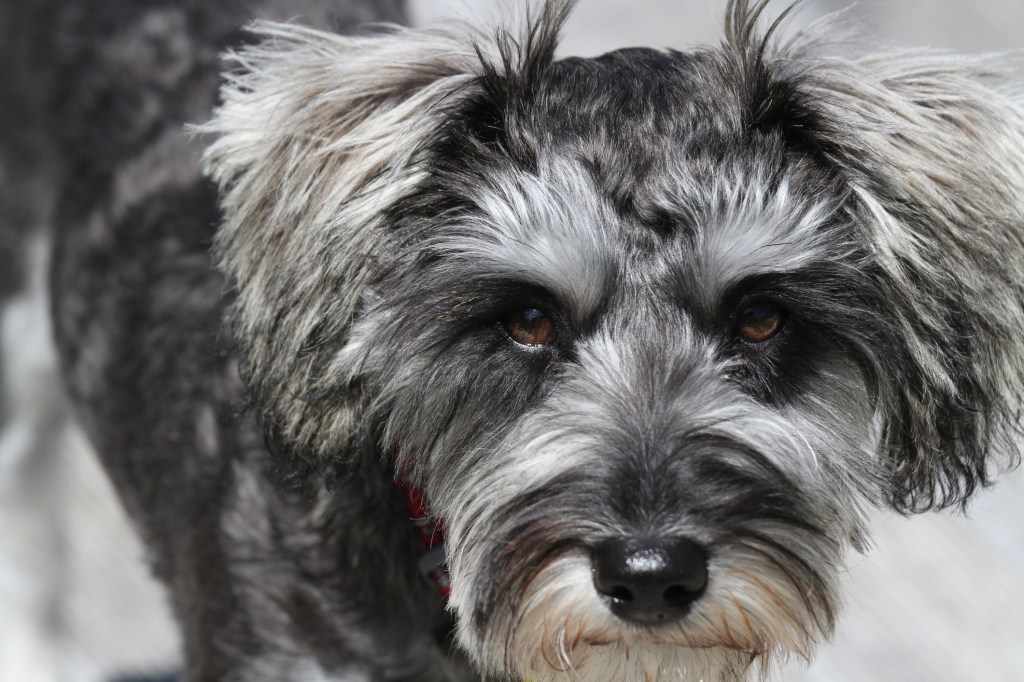
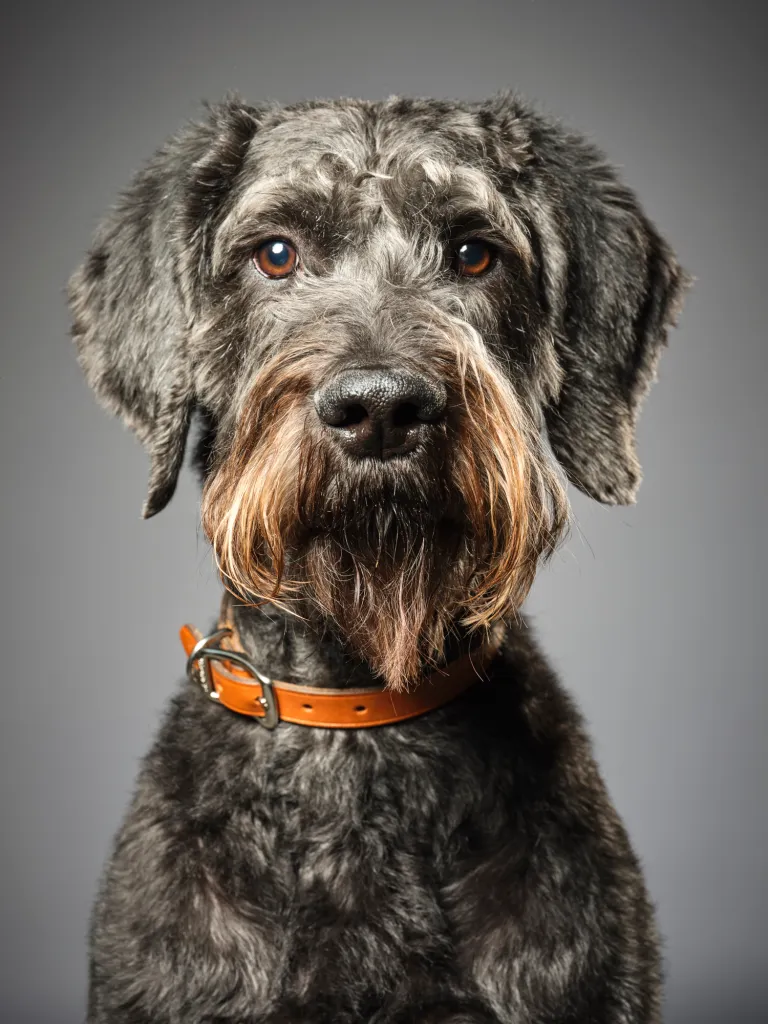
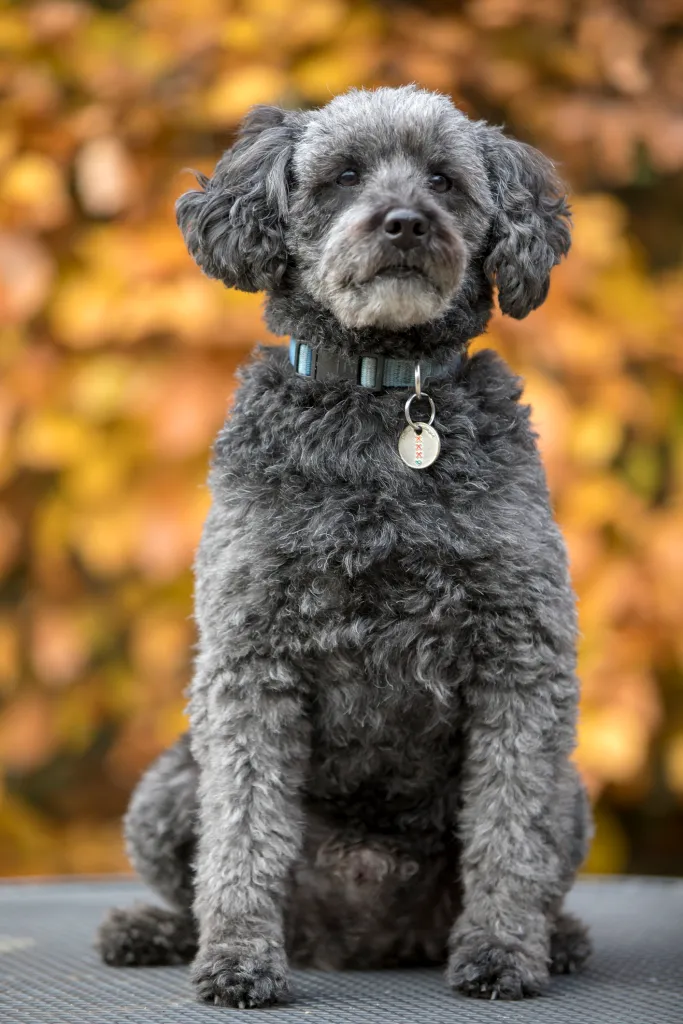
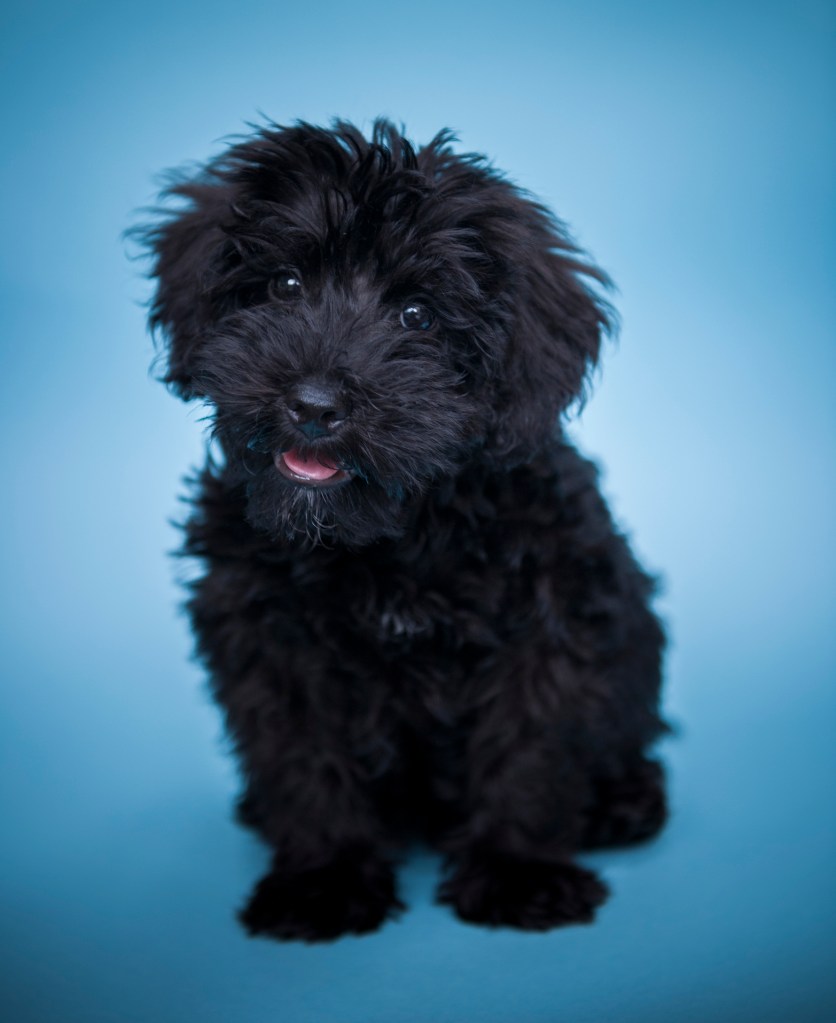
Adaptability
-
Adapts Well To Apartment Living
Looking for the best dog for your apartment? Contrary to popular belief, the suitability of dogs who adapt well to apartment living goes beyond its size. Apartment dwellers have a myriad of dog breeds to choose from as potential companions, with various factors to consider. Some large breeds can adapt well to apartment living and have lower activity levels. Others may require more space and possess higher energy levels. On the other hand, certain small dog breeds with abundant energy can still find contentment with indoor playtime or brisk walks.
However, when selecting a dog that adapts well apartments, it is essential to prioritize your neighbors. Opting for a pet that doesn’t excessively bark and behaves politely when encountering others in shared spaces like is crucial for maintaining a harmonious apartment environment.
In high-rise settings, it’s worth noting that numerous small dogs may exhibit a propensity for high energy and frequent barking. This makes them less suitable for apartment living. Therefore, desirable qualities in an apartment dog encompass being quiet, low-energy, and displaying polite behavior towards other residents.
Factors To Consider When Choosing A Dog For An Apartment
When considering dogs that adapt well to apartments, size alone should not be the sole determinant. Apartment dwellers have a wealth of dog breeds to choose from as potential furry companions. It’s important to remember that the size of your living space is just one factor to consider. While some larger breeds can adapt well to apartment living, with lower, others may require more space and have higher energy levels, making them less suitable for smaller apartments. Conversely, certain small dog breeds with higher energy levels can still thrive in apartments, finding contentment through indoor playtime or brisk walks. However, it is crucial to consider your neighbors’ comfort when selecting a dog. Opt for a pet that doesn’t bark excessively and behaves politely when interacting with others in shared spaces.
Therefore, it’s important to prioritize qualities such as being quiet, low-energy, calm indoors, and exhibiting good manners when living in close proximity to other residents. By considering these factors, you can find a dog that will adapt well to apartment living and create a harmonious living environment for everyone involved.
-
Good For Novice Owners
Some dogs are simply easier than others; they take to training better and are fairly easygoing. They’re also resilient enough to bounce back from your mistakes or inconsistencies.
Dogs who are highly sensitive, independent thinking, or assertive may be harder for a first-time dog parent to manage. You’ll get your best match if you take your dog-owning experience into account as you choose your new pooch.
If you’re new to dog parenting, take a look at 101 Dog Tricks and read up on how to train your dog!
-
Sensitivity Level
Some dogs will let a stern reprimand roll off their backs, while others take even a dirty look to heart. Low-sensitivity dogs, also called “easygoing,” “tolerant,” “resilient,” and even “thick-skinned,” can better handle a noisy, chaotic household, a louder or more assertive owner, and an inconsistent or variable routine. Do you have young kids, throw lots of dinner parties, play in a garage band, or lead a hectic life? Go with a low-sensitivity dog.
-
Tolerates Being Alone
Some breeds bond very closely with their family and are more prone to worry or even panic when left alone by their owner. An anxious dog can be very destructive–barking, whining, chewing, and otherwise causing mayhem. These breeds do best when a family member is home during the day or if you can take the dog to work.
-
Tolerates Cold Weather
Breeds with very short coats and little or no undercoat or body fat, such as Greyhounds, are vulnerable to the cold. Dogs with a low cold tolerance need to live inside in cool climates and should have a jacket or sweater for chilly walks. You can find a great jacket for your dog here!
-
Tolerates Hot Weather
Dogs with thick, double coats are more vulnerable to overheating. So are breeds with short noses, like Bulldogs or Pugs, since they can’t pant as well to cool themselves off. If you want a heat-sensitive breed, your dog will need to stay indoors with you on warm or humid days, and you’ll need to be extra cautious about exercising your dog in the heat.
All-around friendliness
-
Affectionate With Family
When it comes to unconditional love and unwavering loyalty, few animals can rival the affectionate nature of dogs. These remarkable creatures have earned their reputation as man’s best friend, and many breeds are particularly renowned for their love and devotion to their families. With their warm hearts and wagging tails, affectionate family dogs enrich the lives of their owners in countless ways.
One such breed known for its affectionate demeanor is the Golden Retriever. With their gentle temperament and friendly disposition, Golden Retrievers form deep bonds with their families. They eagerly participate in family activities, whether it’s a game of fetch in the yard or cuddling on the couch during a movie night. Their expressive eyes and ever-wagging tails are a testament to the joy they feel in the presence of their loved ones.
Another family-favorite breed is the Labrador Retriever. Renowned for their playful and patient nature, Labradors are excellent companions for children and adults alike. They readily engage in playtime with the kids, showcasing their boundless energy and enthusiasm. But when the day winds down, they seamlessly transition into loving and gentle cuddle buddies, comforting their family members with their warm presence.
Beyond specific breeds, mixed-breed dogs also have a special place in the hearts of families seeking affectionate companions. The shelter dogs, in particular, form deep connections with their adoptive families. They seem to understand the second chance they’ve been given and repay it with endless love and gratitude.
How To Know If A Dog Is Good With Families
The affectionate nature of family dogs extends beyond play and cuddles. Dogs have a remarkable ability to sense their owner’s emotions, offering comfort and support during difficult times. Whether it’s a wagging tail after a long day at work or a sympathetic nuzzle during moments of sadness, they prove time and again that they are attuned to their family’s needs.
It is important to note that not all dogs of the same breed will be equally affectionate. Some dogs may be more independent or aloof, while others may be more clingy or demanding of attention. The best way to find out how affectionate a dog is is to meet them in person and interact with them.
-
Kid-Friendly
Being gentle with children, sturdy enough to handle the heavy-handed pets and hugs they can dish out, and having a blasé attitude toward running, screaming children are all traits that make a kid-friendly dog. You may be surprised by who’s on that list: Fierce-looking Boxers are considered good with children, as are American Staffordshire Terriers (which are considered Pit Bulls). Small, delicate, and potentially snappy dogs such as Chihuahuas aren’t always so family-friendly.
**All dogs are individuals. Our ratings are generalizations, and they’re not a guarantee of how any breed or individual dog will behave. Dogs from any breed can be good with children based on their past experiences, training on how to get along with kids, and personality. No matter what the breed or breed type, all dogs have strong jaws, sharp pointy teeth, and may bite in stressful circumstances. Young children and dogs of any breed should always be supervised by an adult and never left alone together, period.
-
Dog Friendly
Friendliness toward dogs and friendliness toward humans are two completely different things. Some dogs may attack or try to dominate other dogs, even if they’re love-bugs with people; others would rather play than fight; and some will turn tail and run. Breed isn’t the only factor. Dogs who lived with their littermates and mother until at least six to eight weeks of age and who spent lots of time playing with other dogs during puppyhood, are more likely to have good canine social skills.
-
Friendly Toward Strangers
Stranger-friendly dogs will greet guests with wagging tails and nuzzles; others are shy, indifferent, or even aggressive. However, no matter what the breed, a dog who was socialized and exposed to lots of different types, ages, sizes, and shapes of people as a puppy will respond better to strangers as an adult. Remember that even friendly dogs should stay on a good, strong leash like this one in public!
Health And Grooming Needs
-
Amount Of Shedding
If you’re going to share your home with a dog, you’ll need to deal with some level of dog hair on your clothes and in your house. However, shedding does vary greatly among the breeds. Some dogs shed year-round, some “blow” seasonally, some do both, and some shed hardly at all. If you’re a neatnik, you’ll need to either pick a low-shedding breed or relax your standards. To help keep your home a little cleaner, you can find a great de-shedding tool here!
-
Drooling Potential
Drool-prone dogs may drape ropes of slobber on your arm and leave big, wet spots on your clothes when they come over to say hello. If you’ve got a laid-back attitude toward slobber, fine; but if you’re a neatnik, you may want to choose a dog who rates low in the drool department.
-
Easy To Groom
Some breeds are brush-and-go dogs; others require regular bathing, clipping, and other grooming just to stay clean and healthy. Consider whether you have the time and patience for a dog who needs a lot of grooming, or the money to pay someone else to do it.
-
General Health
Due to poor breeding practices, some breeds are prone to certain genetic health problems, such as hip dysplasia. This doesn’t mean that every dog of that breed will develop those diseases; it just means that they’re at an increased risk.
If you’re adopting a puppy, it’s a good idea to find out which genetic illnesses are common to the breed you’re interested in. You may also want to ask if your shelter or rescue has information about the physical health of your potential pup’s parents and other relatives.
-
Potential For Weight Gain
Some breeds have hearty appetites and tend to put on weight easily. As in humans, being overweight can cause health problems in dogs. If you pick a breed that’s prone to packing on pounds, you’ll need to limit treats, make sure they get enough exercise, and measure out their daily food servings into regular meals rather than leaving food out all the time.
Ask your vet about your dog’s diet and what they recommend for feeding your pooch to keep them at a healthy weight. Weight gain can lead to other health issues or worsen problems like arthritis.
-
Size
Get ready to meet the giants of the doggy world! Large dog breeds aren’t just big balls of fluff, they’re like loving, oversized teddy bears on a mission to steal your heart. Need some convincing? Let’s dive into the awesome benefits of owning one!
First things first, these pooches are a living security system! With their impressive size and thunderous barks, they’ll have any would-be intruder running for the hills. Talk about peace of mind! Plus, who needs an alarm when you’ve got a furry giant protecting your castle?
But that’s not all. Large dog breeds are all about loyalty and devotion. They’ll stick by your side through thick and thin, becoming your most dedicated bestie. Their love knows no bounds! When you have a giant fluffball showing you unconditional love, you’ll feel like the luckiest human on the planet.
Now, let’s talk about their talents. These big fellas are the ultimate working partners. With brains and brawn, they’re up for any challenge. From search and rescue missions to lending a helping paw to those in need, these dogs are superheroes in fur coats. They’ll make you proud every step of the way!
Don’t let their size fool you—these gentle giants have hearts as big as their paws. They’re incredible with kids and other pets, spreading their love like confetti. Their patience and kindness make them perfect family pets, ensuring harmony in your household.
Oh, and get ready to break a sweat! These dogs are fitness enthusiasts, and they’ll keep you on your toes. Daily walks, jogs, and play sessions will not only keep them happy and healthy but will also give you a reason to ditch the couch and join in on the fun. It’s a win-win situation!
So, if you’re ready for a dose of big love, go ahead and consider a large dog breed. They’re the best wing-dog you could ever ask for, ready to make your life a thousand times more exciting, loving, and downright awesome! Get ready for the big adventure of a lifetime!
Trainability
-
Easy To Train
Easy-to-train dogs are more adept at forming an association between a prompt (such as the word “sit”), an action (sitting), and a consequence (getting a treat) very quickly. Other dogs need more time, patience, and repetition during training.
Many breeds are intelligent but approach training with a “What’s in it for me?” attitude, in which case you’ll need to use rewards and games to teach them to want to comply with your requests.
Related:
10 Fun, Impressive Tricks You Can Teach Any Dog
-
Intelligence
Dogs who were bred for jobs that require decision making, intelligence, and concentration, such as herding livestock, need to exercise their brains, just as dogs who were bred to run all day need to exercise their bodies. If they don’t get the mental stimulation they need, they’ll make their own work–usually with projects you won’t like, such as digging and chewing. Obedience training and interactive dog toys are good ways to give a dog a brain workout, as are dog sports and careers, such as agility and search and rescue.
-
Potential For Mouthiness
Common in most breeds during puppyhood and in Retriever breeds at all ages, mouthiness means a tendency to nip, chew, and play-bite (a soft, fairly painless bite that doesn’t puncture the skin). Mouthy dogs are more likely to use their mouths to hold or “herd” their human family members, and they need training to learn that it’s fine to gnaw on chew toys, but not on people. Mouthy breeds tend to really enjoy a game of fetch, as well as a good chew on a toy that’s been stuffed with kibble and treats.
-
Prey Drive
Dogs with a high prey drive have an instinctive desire to stalk, capture, and prey upon potential food sources. Dogs who were bred to hunt, such as Terriers, have an inborn desire to chase — and sometimes kill — other animals. Anything whizzing by — such as cats, squirrels, and perhaps even cars — can trigger that instinct.
How to address a high prey drive
Off-leash adventures are too great a temptation for pups who will wander and hunt. Dogs who like to chase need to be leashed. And, even on a leash, you may experience your dog pulling on the leash to reach rodents or birds in their sight. Otherwise, these pups should be kept in a fenced area when outdoors. If your pup has a high prey drive, you’ll need a high, secure fence in your yard.
These breeds generally aren’t a good fit for homes with smaller pets that can look like prey, such as cats, hamsters, or small dogs. Breeds that were originally used for bird hunting, on the other hand, generally won’t chase, but you’ll probably have a hard time getting their attention when there are birds flying by.
Other behavioral concerns
Observing your dog’s prey drive, which is instinctual and biologically-rooted, is not the same as observing aggression. Much aggression is born of fear and anxiety, especially in the case of dog aggression toward humans.
The tendency to wander, even into oncoming traffic, can produce diasterious results for pups with predatory instincts. It can also lead to pups being bitten by snakes or attacked by other wild animals they may pursue while on the hunt.
-
Tendency To Bark Or Howl
Some breeds sound off more often than others. When choosing a breed, think about how often the dog vocalizes. Learn more about breeds with a tendency to bark or howl.
If you’re considering a hound, would you find their trademark howls musical or maddening? If you’re considering a watchdog, will a city full of suspicious “strangers” put your pup on permanent alert? Will the local wildlife literally drive your dog wild? Do you live in housing with noise restrictions? Do you have neighbors nearby? Then you may wish to choose a quieter dog.
-
Wanderlust Potential
Some breeds are more free-spirited than others. Nordic dogs such as Siberian Huskies were bred to range long distances, and given the chance, they’ll take off after anything that catches their interest. And many hounds simply must follow their noses–or that bunny that just ran across the path–even if it means leaving you behind.
Exercise needs
-
Energy Level
High-energy dogs are always ready and waiting for action. Originally bred to perform a canine job of some sort, such as retrieving game for hunters or herding livestock, they have the stamina to put in a full workday. They need a significant amount of exercise and mental stimulation, and they’re more likely to spend time jumping, playing, and investigating any new sights and smells.
Low-energy dogs are the canine equivalent of a couch potato, content to doze the day away. When picking a breed, consider your own activity level and lifestyle, and think about whether you’ll find a frisky, energetic dog invigorating or annoying.
-
Intensity
A vigorous dog may or may not have high energy, but everything they do, they do with vigor: they strain on the leash (until you train them not to), try to plow through obstacles, and even eats and drinks with great big gulps. These dynamos need lots of training to learn good manners, and may not be the best fit for a home with young kids or someone who’s elderly or frail. A low-vigor dog, on the other hand, has a more subdued approach to life.
-
Exercise Needs
Some breeds do fine with a slow evening stroll around the block. Others need daily, vigorous exercise, especially those that were originally bred for physically demanding jobs, like herding or hunting.
Without enough exercise, these breeds may put on weight and vent their pent-up energy in ways you don’t like, such as barking, chewing, and digging. Breeds that need a lot of exercise are good for outdoorsy, active people, or those interested in training their dog to compete in a high-energy dog sport, such as agility.
-
Potential For Playfulness
Some dogs are perpetual puppies — always begging for a game — while others are more serious and sedate. Although a playful pup sounds endearing, consider how many games of fetch or tag you want to play each day, and whether you have kids or other dogs who can stand in as playmates for the dog.
Schnoodle Overview
The Schnoodle is cheerful and intelligent. Described as “forever happy,” this designer dog’s favorite joys in life are playing and hanging out with his family. Bred to be a companion dog, he’s proven that he can do well in agility trials and as a therapy dog. He makes a terrific jogging companion and his love of activity can get you off the couch. Despite that, he will also happily cuddle on the couch with you.
A Schnoodle will fill your life and lap with both love and laughter. This breed is loyal like the Schnauzer and fun-loving like the Poodle. Like his Schnauzer parent, a Schnoodle has a protective nature and makes a good watch dog. Similar to his Poodle parent, he’s smart and affectionate. That said, he will bark, sometimes too much (a trait that should be nipped in the bud when he’s young).
Schnauzers are solid terriers and tend toward being a bit stubborn and independent. At the same time, they are known for being extremely loyal. Contrastingly, the Poodle is smart, agile, and active with a high-maintenance coat. In the best examples of this hybrid, there’s less of the Poodle’s high energy and less of the Schnauzer’s stubbornness.
A Schnoodle loves car rides (particularly when he’s going to visit someone he likes), playing fetch, and just having a good time. Fetch isn’t the only activity he loves; he enjoys puzzle games and will even play hide-and-seek. He’s a silly boy and will do what some refer to as the “butt tucks” and others call the Schnoodle 500 — running fast in a circle with the hind end tucked up. It’s just a form of play that means he’s elated.
Accordingly, the Schnoodle should have plenty of exercise every day, at least 30 to 60 minutes. Both Schnauzers and Poodles are smart, so this hybrid requires daily mental stimulation as well. A Schnoodle who isn’t properly exercised or stimulated can become destructive and difficult to handle. Contemplate the combination of smart, problem-solving and bored out of his mind, and you’ll get the idea.
This pup also has an unusual propensity to use his front paws as hands to hold toys and blankets. There’s a terrier in there, and some Schnoodles like to dig more than others. Unfortunately, some really enjoy digging. Some really enjoy barking, too.
There are three different variations of both Schnauzers and Poodles, making for a wide range of sizes in the Schnoodle. The larger ones are still relatively uncommon. Schnauzer varieties include Miniature, Standard, and Giant; Poodle varieties include Toy, Miniature, and Standard. There is no breed standard for Schnoodles — nor any breed clubs — so, as of yet, their different sizes are currently defined as Toy, Miniature, Standard., and Giant Most Schnoodles are small, because the most common cross uses a Miniature Schnauzer and a Toy or Miniature Poodle.
Notably, size may make a difference in the personality of this hybrid. While a Miniature or Standard Schnauzer can be a handful, the Giant Schnauzer has their feistiness many times over — he’s a dominant dog who needs a firm hand. A large Schnoodle should have a softer temperament than a Giant Schnauzer. That said, if you’re interested in a large Schnoodle, keep the Giant Schnauzer temperament in mind, because it’s a wild card.
As with any hybrid, there’s also a huge difference between a Schnoodle whose purebred parents have been carefully selected for temperament versus a dog from an irresponsible breeder. In the latter case, someone could simply slap a litter together because she has a purebred Schnauzer and lives down the street from a purebred Poodle. When the parents are carefully selected, the Schnoodle is a great dog. Hybrid vigor can work wonders, but poor parent selection can result in the worst traits of both breeds with none of the good ones. Unfortunately, the hybrid has become popular enough for puppy mills to get on the bandwagon, and unscrupulous breeders who don’t give a hoot about the puppy’s health or temperament are everywhere. If you want the temperament that the hybrid is meant to provide, get a puppy from a responsible breeder who has taken care in selecting the parents. You can also adopt from a reputable rescue or shelter, since these pups are now appearing in those places.
A Schnoodle loves the people in his life and thrives when he’s with them. A small Schnoodle can do well in an apartment, but the larger Schnoodle does better in homes with fenced yards. Schnoodles shouldn’t live outdoors or in kennels, since they can suffer from separation anxiety if left alone for long periods at a time.
Schnoodle Highlights
Schnoodles are a cross between a Poodle and a Schnauzer, and they are known for being intelligent, friendly, and hypoallergenic. They come in three sizes: Standard, Miniature, and Toy.
Here are some of the highlights of the Schnoodle breed:
- Intelligence: Schnoodles are highly intelligent dogs that are easy to train. They can learn basic commands quickly and can be trained to do more complex tasks, such as agility or obedience.
- Friendliness: Schnoodles are known for being friendly and outgoing dogs. They love to be around people and other animals, and they make great family pets.
- Hypoallergenic: Schnoodles are considered to be hypoallergenic, which means that they do not shed as much as other dog breeds. This makes them a good choice for people with allergies.
- Active: Schnoodles are active dogs that need plenty of exercise. They enjoy playing fetch, going for walks, and running around.
- Loyal: Schnoodles are loyal dogs that form strong bonds with their owners. They love to cuddle and be petted, and they will always be there to greet you at the door.
If you are looking for a smart, friendly, and hypoallergenic dog, the Schnoodle may be the perfect breed for you.
Here are some additional things to consider before getting a Schnoodle:
- Grooming: Schnoodles need to be groomed regularly to keep their coats looking their best. This includes brushing, trimming, and bathing.
- Training: Schnoodles are intelligent dogs, but they can also be stubborn. They need to be trained consistently and firmly.
- Exercise: Schnoodles need plenty of exercise to stay healthy and happy. They should be walked for at least 30 minutes a day.
Schnoodle History
The Schnoodle was developed in the 1980s, when the interest began to grow in Poodle crosses. The original goal with the Schnoodle was to create a low-shedding, low-dander family dog. Although the Schnoodle hasn’t quite gained the popularity of other “designer” breeds, there’s a strong following that has created a demand for Schnoodle puppies.
The Schnoodle is generally the result of breeding between a Schnauzer and a Poodle, although some breeders have started breeding multigenerational Schnoodles (Schnoodles bred to other Schnoodles). Right now there are no breed clubs or standards, but efforts have begun to create both.
Schnoodles can come in a variety of sizes, since there are three Poodle sizes and three Schnauzer sizes. The range of possibilities has created an interesting variety of hybrids. Despite that, Schnoodles have traditionally been small dogs. The introduction of the Giant Schnauzer and Standard Poodle into the mix is the most recent variation, producing a dog of a different temperament from the small, cuddly Schnoodle.
Schnoodle Size
The size of the Schnoodle depends on the size of the parents: a Standard Poodle bred to a Giant Schnauzer will produce offspring who will be the size of their large parents. If a Standard Poodle and Standard Schnauzer are crossed, than the result could be sizes ranging between both the Miniature Schnoodle and the Standard Schnoodle. This uncertainty is part of the joy of a mixed breed: the ultimate details can be a welcome surprise.
There are no breed standards for the Schnoodle, so predicting adult size isn’t an exact science. Like any mixed breed, the variation involved can eliminate guarantees of size. What follows are ballpark estimates, and while these are fairly reliable, don’t bet the doghouse on them. There are three different variations of both Schnauzers and Poodles: Miniature, Standard, and Giant for the Schnauzer; and Toy, Miniature, and Standard for the Poodle. Mixing and matching can add up to some interesting ranges and the variety is enticing. However, most Schnoodles tend to be 20 pounds or less.
- Toy Schnoodles range from 10 to 12 inches in height and weigh 6 to 10 pounds.
- Miniature Schnoodles range from 12 to 15 inches in height and weigh 13 to 20 pounds.
- Standard Schnoodles range from 15 to 26 inches in height and weigh 20 to 75 pounds.
- Giant Schnoodles range from 20 to 28 inches in height and weigh 50 to 110 pounds.
Schnoodle Personality
The well-bred Schnoodle is a wonderfully happy, loyal, and intelligent companion. He enjoys having fun and aims for a life filled with love and play. He’s protective of his family, makes a great watchdog, and loves to participate in all aspects of family life. He can have the terrier’s suspicious attitude toward people and dogs — or not, depending on the genetic dice roll.
A Schnoodle can have a strong temperament but generally is loving and loyal to his people. As with every dog, the Schnoodle needs early socialization — exposure to many different people, sights, sounds, and experiences — when they’re young. Socialization helps ensure that your Schnoodle puppy grows up to be a well-rounded dog. Enrolling him in a puppy kindergarten class is a great start. Inviting visitors over regularly — as well as taking him to busy parks, stores that allow dogs, and on leisurely strolls to meet neighbors — will also help him polish his social skills.
Schnoodle Health
The notion of hybrid vigor is worth understanding if you’re looking for a Schnoodle. Hybrid vigor isn’t necessarily characteristic of mixed breeds. It occurs when new blood is brought in from outside the usual breeding circle — it’s the opposite of inbreeding. However, there is a general misconception that hybrid vigor automatically applies to mixed breeds. If the genetic pool for the mixed breed remains the same over time, the offspring won’t have hybrid vigor. And, if a purebred breeder brings in a dog from a different line, those puppies will have hybrid vigor, even though they’re purebred.
Schnoodles are generally healthy, but like all breeds, they’re prone to certain health conditions. Not all Schnoodles will get any or all of these diseases, but it’s important to be aware of them if you’re considering this breed. If you’re buying a puppy, find a good breeder who will show you health clearances for both your puppy’s parents. Health clearances prove that a dog has been tested for and cleared of a particular condition.
In Schnoodles, you should expect to see health clearances from the Orthopedic Foundation for Animals (OFA) for hip dysplasia (with a score of fair or better), elbow dysplasia, hypothyroidism, and Von Willebrand Disease (VWD); from Auburn University for thrombopathia; and from the Canine Eye Registry Foundation (CERF) certifying that eyes are normal. You can confirm health clearances by checking the OFA website.
- Progressive Retinal Atrophy (PRA): This is a family of eye diseases that involves the gradual deterioration of the retina. Early in the disease, affected dogs become night-blind; they lose sight during the day as the disease progresses. Many affected dogs adapt well to their limited or lost vision, as long as their surroundings remain the same.
- Cataracts: These cause opacity on the lens of the eye, resulting in poor vision. The dog’s eye(s) will have a cloudy appearance. Cataracts usually occur in old age and sometimes can be surgically removed to improve vision.
- Legg-Calve-Perthes Disease: This involves the hip joint. If your Schnoodle has Legg-Perthes, the blood supply to the head of the femur (the large rear leg bone) is decreased, and the head of the femur that connects to the pelvis begins to disintegrate. The first symptoms, limping and atrophy of the leg muscle, usually occur when puppies are four to six months old. Surgery can correct the condition, usually resulting in a pain-free puppy.
- Patellar Luxation: Also known as slipped stifles, this is a common problem in small dogs. The patella is the kneecap. Luxation means dislocation of an anatomical part (as a bone at a joint). Patellar luxation is when the knee joint (often of a hind leg) slides in and out of place, causing pain. This can be crippling, although many dogs lead relatively normal lives with this condition.
- Epilepsy: This is a neurological condition that’s often, but not always, inherited. It can cause mild or severe seizures that may show themselves as unusual behavior (such as running frantically as if being chased, staggering, or hiding) or even by falling down, limbs rigid, and losing consciousness. Seizures are frightening to watch, but the long-term prognosis for dogs with idiopathic epilepsy is generally very good. It’s important to take your dog to the vet for proper diagnosis (especially since seizures can have other causes) and treatment.
- Diabetes Mellitus: This is a disorder in which the body cannot regulate blood sugar levels, due to improper levels of insulin. Insulin lets glucose into cells to use for energy; without insulin, the glucose doesn’t enter the cells and those cells become “hungry.” A diabetic dog will eat more food to try to compensate, but he’ll lose weight because food is not being used efficiently. Symptoms of diabetes are excessive urination and thirst, increased appetite, and weight loss. Diabetes can be controlled by diet and the administration of insulin.
- Addison’s Disease: Also known as hypoadrenocorticism, this extremely serious condition is caused by an insufficient production of adrenal hormones by the adrenal gland. Most dogs with Addison’s disease vomit, have a poor appetite, and have little energy. Because these signs are vague and can be mistaken for other conditions, it’s easy to misdiagnose this disease until it reaches more advanced stages. More severe signs occur when a dog is stressed or when potassium levels become high enough to interfere with heart function, causing severe shock and death. If your vet suspects Addison’s, she may perform a series of tests to confirm the diagnosis.
- Gastric Torsion: Also called bloat, this life-threatening condition can affect large, deep-chested dogs — so it’s unlikely to be a problem for most Schnoodles, who tend to be small. But if your Schnoodle is on the large side, and had a Giant Schnauzer for a parent, this condition is worth knowing about. It’s a particular risk if the dog is fed one large meal a day, eats rapidly, drinks large volumes of water after eating, and exercises vigorously after feeding. Bloat is more common among older dogs. GDV occurs when the stomach is distended with gas or air and then twists (torsion). The dog is unable to belch or vomit to rid himself of the excess air in the stomach, and the normal return of blood to the heart is impeded. Blood pressure drops and the dog goes into shock. Without immediate medical attention, the dog can die. Suspect bloat if your dog has a distended abdomen and is salivating excessively and retching without throwing up. He also may be restless, depressed, lethargic, and weak, with a rapid heart rate. It’s important to get your dog to the vet as soon as possible if you see these signs.
Schnoodle Care
Although the energy level of the Schnoodle is reflective of the parents, and is therefore variable, expect to exercise your dog for about 30 to 60 minutes per day. Some require less while others require a bit more. Schnoodles enjoy brisk walks and make great jogging companions.
Schnoodles can adapt to a variety of residences, but take size into consideration. A Toy or Miniature Schnoodle will do well in an apartment or condo, but a larger Standard may not. Ideally, a home with a fenced yard is best for all Schnoodles. A Schnoodle should not live outside or in a kennel; they’re companion dogs and do best when they are inside the house with their owners.
Schnoodles can suffer from separation anxiety when left alone for long periods of time. This can lead to barking and destructive behaviors. Schnoodles aren’t a noisy breed, but if they become bored or are left alone for long periods, they may begin the habit. And once that habit starts, it can be difficult to stop.
Schnoodle Feeding
Recommended daily amount: 3/4 to 1 cup of high-quality dry food a day for the most common size of Schnoodle, weighing from 15 to 20 pounds. You’ll need to feed yours less if he’s smaller, and significantly more if a Giant Schnauzer is one of the parents. Keep your Schnoodle in good shape by measuring his food and feeding him twice or three times a day rather than free feeding, or leaving food out all the time.
Check with your veterinarian if you’re unsure about the feeding needs of your particular dog. How much your adult dog eats depends on his size, age, build, metabolism, and activity level. Dogs are individuals, just like people, and they don’t all need the same amount of food. It almost goes without saying that a highly active dog will need more than a couch potato dog.
The quality of dog food you buy also makes a difference — the better the dog food, the further it will go toward nourishing your dog and the less of it you’ll need to shake into your dog’s bowl. When possible, minimize the amount of highly processed food your pup is consuming. Consider incorporating human-grade food and fresh vegetables into your pup’s diet to enhance their health and longevity. Talk to your vet about switching your Schnoodle to a vegetarian diet if they suffer from certain health issues such as food allergies, skin issues, or even coat dullness.
If you’re unsure whether he’s overweight, give him the eye test and the hands-on test. First, look down at him. You should be able to see a waist. Then place your hands on his back, thumbs along the spine, with the fingers spread downward. You should be able to feel but not see his ribs without having to press hard. If you can’t, he needs less food and more exercise. For more on feeding your Schnoodle, see our guidelines for buying the right food, feeding your puppy, and feeding your adult dog.
Schnoodle Coat Color And Grooming
The Schnoodle coat can be black, gray, silver, brown, white, apricot, sable, black and white, black and tan, and even parti-color.
The Schnoodle coat is meant to resemble a Schnauzer puppy’s: soft and wavy. Generally, first-generation litters have a wavy coat that’s soft in texture and remains soft throughout the dog’s life. The coat shouldn’t be wiry like an adult Schnauzer’s, nor have the tight curls of a Poodle. Second-generation Schnoodles are more likely to have either the Poodle’s curly coat or the wiry Schnauzer coat. The wavy coat occurs in multigenerational breeding.
While Schnoodles are low-shedding dogs, they must be clipped or trimmed. The amount of grooming needed for a Schnoodle really depends on the coat of the individual dog. If your dog has the soft, wavy type of coat, brush once or twice a week to prevent tangles and mats. The Schnoodle will also need to be bathed on an as-needed basis to keep the coat soft. The best time to brush is after a bath. Drying the coat with a hair dryer will help prevent any mats from forming.
A Schnoodle with the rough, wiry coat of the Schnauzer parent will not require as much grooming as the silky-haired variety, but weekly brushing is best, with some trimming to keep it tidy and free of dead hair. A Schnoodle with the Poodle’s curly coat needs regular brushing and should be clipped every six to eight weeks.
Moreover, the Schnoodle proves that both men and dogs look terrific in beards. This pup has distinctive facial hair — highlighting his eyebrows, mustache area, and jawline. Keep their face clean by trimming the hair, taking care to ensure your pooch doesn’t carry crumbs around in his scrumptious locks.
No matter what coat your Schnoodle has, check the ears once a week for dirt, redness, or a bad odor that can indicate an ear infection. Also, wipe them out weekly with a cotton ball dampened with gentle, pH-balanced ear cleaner to prevent problems. This breed can be prone to yeast infections.
Brush your Schnoodle’s teeth at least two or three times a week to remove tartar buildup and the bacteria that lurk inside it. Regular dental care and daily brushing is even better if you want to prevent gum disease and bad breath.
Trim his nails regularly if your dog doesn’t wear them down naturally. If you can hear them clicking on the floor, they’re too long. Short, neatly trimmed nails keep your legs from getting scratched when your Schnoodle enthusiastically jumps up to greet you.
Begin accustoming your Schnoodle to being brushed and examined when he’s a puppy. Handle his paws frequently — dogs are touchy about their feet — and look inside his mouth and ears. Make grooming a positive experience filled with praise and rewards, and you’ll lay the groundwork for easy veterinary exams and other handling when he’s an adult.
As you groom, check for sores, rashes, or signs of infection such as redness, tenderness, or inflammation on the skin and feet or in the ears, nose, mouth, and eyes. Ears should smell good, without too much wax or gunk inside, and eyes should be clear, with no redness or discharge. Your careful weekly exam will help you spot potential health problems early.
Schnoodle Children And Other Pets
Schnoodles make excellent family pets, and they love to play with kids while being the center of attention. Both parent breeds are good with kids, but of course all puppies need to be socialized with children to be comfortable with them. Introducing a five-year old dog to your toddler is a different ballgame than introducing a puppy. The same is true for introducing a dog of any age to a new baby. But when exposed early, Schnoodles and kids get along famously.
As with every breed, you should always teach children how to be gentle with dogs. In particular, educate children on the proper ways to approach and touch dogs. Always supervise any interactions between dogs and young children to prevent any biting or ear or tail pulling on the part of either party. Teach your little ones never to approach any dog while he’s eating or sleeping, and explain why they shouldn’t try to take the dog’s food away. No dog, no matter how friendly, should ever be left unsupervised with a child.
Some pups are known to buckle under the demands of the family cat, but they generally get along with other pets. Schnoodles can play hard with other dogs and aren’t always the best about sharing toys (there’s that stubborn Terrier streak again). With this purpose in mind, socialization from puppyhood makes a big difference in attitude toward other pets. Terriers are bred to go after small critters, so your Schnoodle’s reaction to the family hamster depends on whether he takes after the Schnauzer side of the family or the Poodle side.
Schnoodle Rescue Groups
Schnoodles are often purchased without any clear understanding of what goes into owning one. There are many Schnoodles in need of adoption and or fostering. There are a number of rescues that we have not listed.
Schnoodle Breed Organizations
Finding a reputable dog breeder is one of the most important decisions you will make when bringing a new dog into your life. Reputable breeders are committed to breeding healthy, well-socialized puppies that will make great companions. They will screen their breeding stock for health problems, socialize their puppies from a young age, and provide you with lifetime support.
On the other hand, backyard breeders are more interested in making a profit than in producing healthy, well-adjusted dogs. They may not screen their breeding stock for health problems, and they may not socialize their puppies properly. As a result, puppies from backyard breeders are more likely to have both health and behavioral issues.
